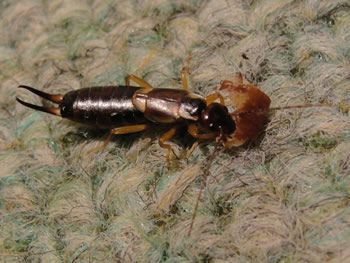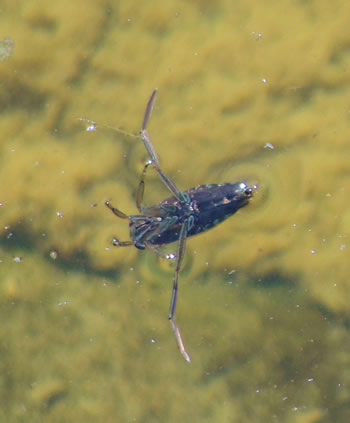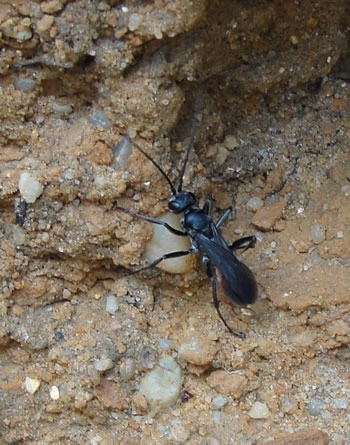The common earwig (Forficula auricularia) is actually still common, unlike many other invertebrates which were once common, hence their common names, but are now less so. There are several species of these insects in the UK and this is by far the most often encountered. They are omnivorous feeding on both plant and dead animal matter;this one is eating a crumb of cake indoors on the carpet. They mate during the autumn and in the springtime the female lays eggs then tends to her offspring feeding and guarding them.The giant earwig(Labidura riparia) is thought to be extinct and was found on the coast right here where i live in southbourne, Bournemouth. It was also called the maritime earwig as it lived on the sea shore amongst the strand line of debris.
 Crickets are very abundant at this time of year including the common speckled bush cricket (Leptophyes punctatissima) . It can be found on many low growing herbaceous plants. Both male and female are in this pocture, the female having a projection on the end of her abdomen called the ovipositor. It is used to position eggs into plant stems or the ground and many insects have them.
Crickets are very abundant at this time of year including the common speckled bush cricket (Leptophyes punctatissima) . It can be found on many low growing herbaceous plants. Both male and female are in this pocture, the female having a projection on the end of her abdomen called the ovipositor. It is used to position eggs into plant stems or the ground and many insects have them.
 Ponds and small water ways are home to bugs called water boatmen or back swimmers.They fly like most species of bug, and can see water reflected from above, just like pond skaters and water beetles. They drop down into ponds and and water troughs to create new generations. There are several species, this is (Corixa punctata) .They are predators of other water creatures.
Ponds and small water ways are home to bugs called water boatmen or back swimmers.They fly like most species of bug, and can see water reflected from above, just like pond skaters and water beetles. They drop down into ponds and and water troughs to create new generations. There are several species, this is (Corixa punctata) .They are predators of other water creatures.
 Many species of wasps are parasitic on other insects, and some specialize in spiders including Britain’s largest spider hunting Pompilid wasp (Cryptocheilus notatus).
Many species of wasps are parasitic on other insects, and some specialize in spiders including Britain’s largest spider hunting Pompilid wasp (Cryptocheilus notatus).

